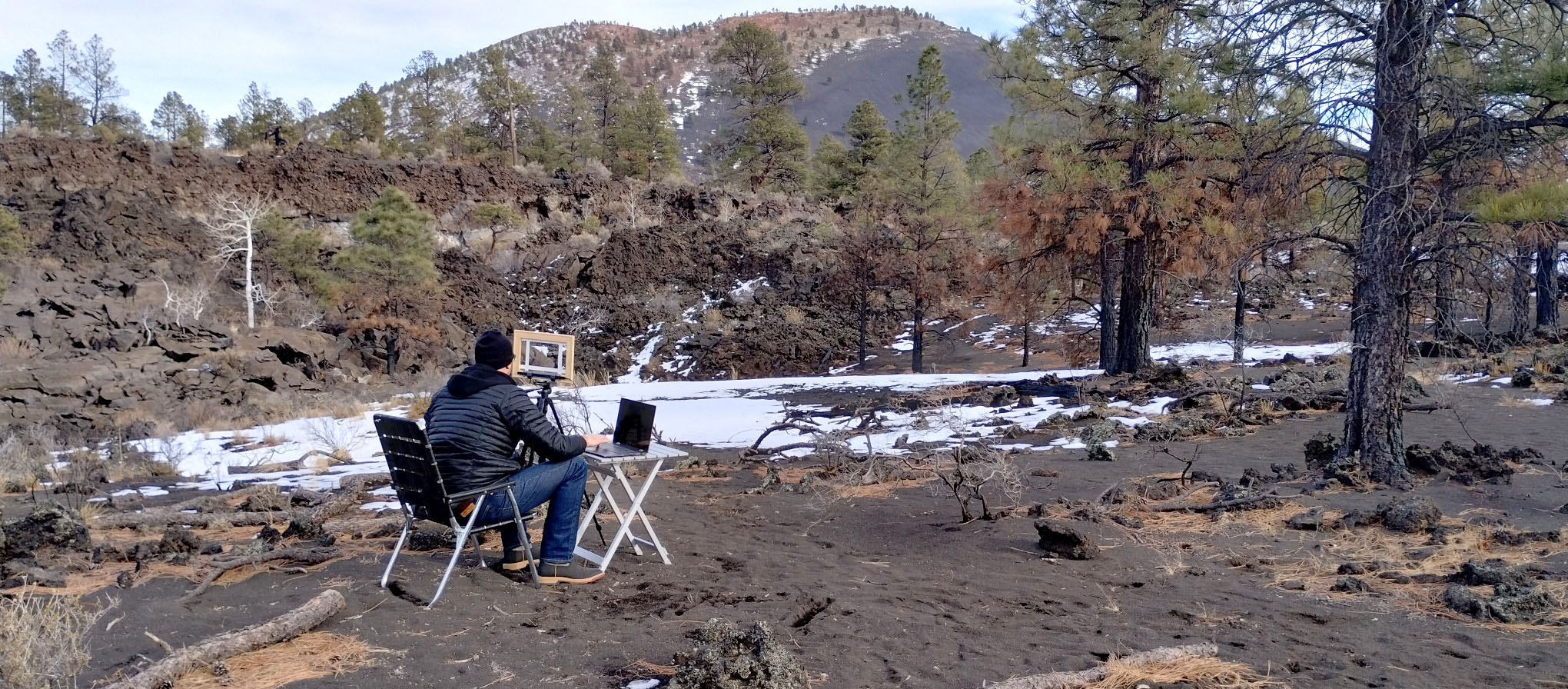Bio

Andy Gambrell drawing en plein air near Sunset Crater Volcano in Arizona with his eye-tracking viewfinder prototype.
Andy Gambrell
Andy Gambrell is an American Abstract Painter. He studied art and art history at the South Carolina Governor's School for the Arts, Furman University, The School of Visual Arts in New York City, and the University of Miami. His work has been featured in over eighty exhibitions, and in 2010, he was recognized as a core member of the contemporary painting movement, the Miami School. According to The Center for Visual Communication of South Florida, the group represented "a new direction in art which is about beauty, esthetic perception, and the joy of human discourse - a revival of themes common in historically significant paintings which have been the foundations of art history." Gambrell’s works are showcased in private collections in the U.S., Canada, Colombia, Switzerland, Germany, China, and New Zealand and can be seen in public collections such as the Black Mountain College Museum and Art Center in Asheville, NC and the Clara M. Lovett Museum of Art in Flagstaff, AZ.
Gambrell’s relationship to the art world is very much colored by his working-class roots. For him, art is an affront to the difficulties of life, and teaching is a social responsibility to equip people with the knowledge and skills to live their best lives. Since 2005, he has developed extensive university curricula in fine art and design. He served as Director of High School Operations for the Princeton Review Headquarters in South Florida, Director of the University of Miami's CAS Gallery, and founding director of UM's Wynwood Project Space. He taught for the University of Miami, Elizabeth City State University, the Savannah College of Art and Design in Atlanta, Furman University, SCAD – Hong Kong, and Northern Arizona University. Gambrell also supports the arts outside of the academy through advocacy projects such as founding a gallery in rural Appalachia to provide a platform for artists outside of urban centers. A proponent of experiencing art in-person, Gambrell occasionally writes art criticism and has authored reviews of exhibitions in the U.S., Canada, Colombia, Switzerland, and Hong Kong.
For Gambrell, the history of art is a living, ongoing visual conversation between the artists of the past and present. His practice and the development of his work have been shaped by working relationships with other artists. In the early years of Gambrell’s career, he worked with outsider visionary apocalyptic painter, William Thomas Thompson (1935-present) in the spiritually charged foothills of Appalachia. Ironically, it was Gambrell’s rigorous engagement with the beliefs of his upbringing that led to his philosophical move away from religion. This intellectual shift from a worldview dependent on explanation to a worldview informed by direct experience was pivotal in Gambrell’s development as an abstract artist.
In 2003, Gambrell moved to Miami to work with Walter Darby Bannard (1934-2016) and became part of an underground community of serious abstract painters. There was a rich studio dialogue between modern masters such as Bannard, a pioneer of post-painterly abstraction, Jules Olitski (1922-2007), a legendary figure in color field painting, and mid-career artists working to advance abstraction outside the interest of the mainstream art world.
A fascination of Gambrell’s is the phenomenon of presence in painting. To the artist’s eye, this gestalt of visual ingredients manifests most elegantly in collage. He finds the work of Irwin Kremen (1925-2020) to be exemplary regarding gestalt and presence. Gambrell visited Kremen's home to discuss collage in 2009 when he was a visiting assistant professor at Elizabeth City State University and Kremen was professor emeritus of clinical psychology with Duke University. To come to terms with the mystery of presence in art and the alchemy of bringing it into being, Gambrell worked exclusively in collage for nearly a decade in cultivation of his current approach to working with paint.
In 2016, a painting professorship took Gambrell to Hong Kong, where he developed an ongoing studio dialogue with Jonathan Jay Lee (1985-present), an illustrator who works with high-profile clients such as Apple, Lamborghini, Disney Plus, Marvel Comics, NatGeo, etc..., but whose work is always grounded in life-lived. Lee’s authentic connection with his subject matter encouraged Gambrell to direct his attention towards the visual experiences that give him pause in his day-to-day life as subject matter for his abstraction, being mindful of visual experience itself in the way that a collage artist might be mindful not to walk past a beautifully distressed piece of discarded paper.
Gambrell’s work reflects a studio practice that is as informed by the best of the past as it is open to the best of the present. He now works with an eye-tracking viewfinder prototype he developed to digitally draw the path of his eyes and compose en plein air. The inspiration for the artist’s paintings generally comes from happenstance encounters with the natural world while walking in the city or hiking in the wilderness. Gambrell’s paintings are a three-fold celebration of the world he sees, his experience of seeing it, and his process of distilling his esthetic emotion into a painted composition.
Home